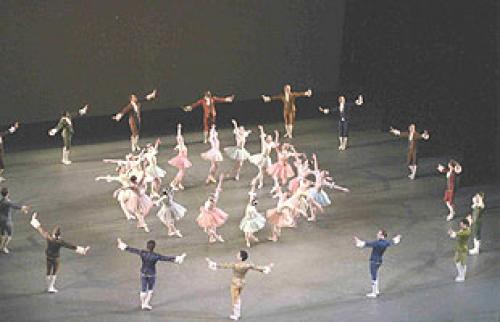I know, I know, Foot in Mouth has been experiencing a time warp lately. Here, for example, are some thoughts on a ballet I saw
more than two weeks ago.
In his “Goldberg Variations,” to the complete Bach score, Jerome
Robbins concludes most of his own variations with a flock of dancers rushing in from the wings as
the dancers already there finish up. It’s a nice touch, a little joke about the dance’s tag-team
structure, which works kind of like the camera in Richard Linklater’s “Slacker,” tracking one person (and story) around a corner only to take off after somebody else. Bach’s variations
don’t point to a theme, as in the conventional theme-and-variations
arrangement, so much as backwards and forwards to one another, and Robbins aims
to do the same.
Depending on your point of view, the result is ballet ad nauseum or ballet ad
infinitum. Critics have been divided on this
question since the dance’s debut in 1971. Arlene Croce
dubbed the New York City Ballet work “ninety minutes of hard labor”; other critics, including me, have
experienced it as waves on waves of delicious invention. When the performance
is good, each time the dancers arrive from the wings I am excited–and grateful–for more. Only the middle of “The Goldberg Variations” sags.
But the piece’s power to sustain attention and delight
depends on the dancers knowing how to fill the space–front and back. In
recognition of Bach’s architectural splendor, the choreographic configurations–circles
inside of circles, folk dance lines, zigzags, and many walking formations–count
for at least as much as the individual steps. Negative space is especially
charged. In one number, a group advances from the wing upstage while another
faces them as they walk backwards into the opposite wing downstage. The dancers may move almost
as casually as people on the street, but the courtliness of the occasion is palpable:
the regal advance, the gracious retreat, and the electricity of the space between.
Except for the three romantic pas de deux in the dance’s second
half, the steps are plain throughout. But for plain not to devolve into meager or dull–for
the movement to animate the space as Bach has animated
time in linking past variation to future–the dancers need to
relinquish the customary forward pitch of the body that Balanchinean speed demands and feel their backs from
crown to foot: the heel’s pressure against the floor, the flex of the haunches,
the expansive shallow in the upper back, the tautness of the stalk of neck.
In one of the short archival videos introducing each Robbins
evening this season, we see the choreographer working with a young Damian Woetzel on
the rumba solo in “Fancy Free.” At one point, the dancer goes from being curved
to the floor in profile to upright facing front. Woetzel makes
that transition like the sun rising from the ocean. Robbins tells him to unfurl
the spine like a fern. He wants the drama not along the horizon
but up and down. He often wants that.
If the “Goldberg” dancers imagined themselves floating belly
up in cool water on a hot day, the submerged skin taking on its own temperature and character, or riding a bike fast enough to feel the breeze blowing off their backs, they’d
do better by this dance, which is only really alive when the back is.
The New York City
Ballet will perform “The Goldberg Variations” once more this year, on Tuesday
July 22 at the Saratoga Springs Performing Arts Center upstate. Longtime
Village Voice critic Deborah Jowitt will present a pre-performance talk at 7
pm. (Performance at 8 pm.) Visit the SPAC website
for more info.
Photo by Paul Kolnik for the New York City Ballet.


Leave a Reply